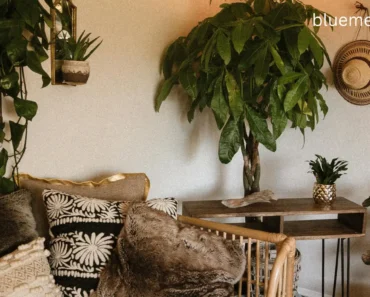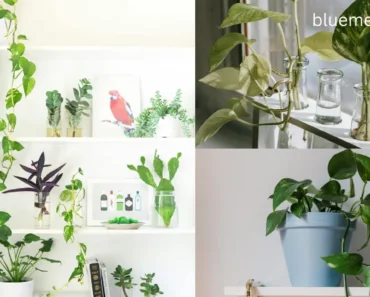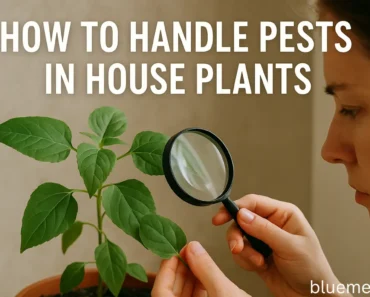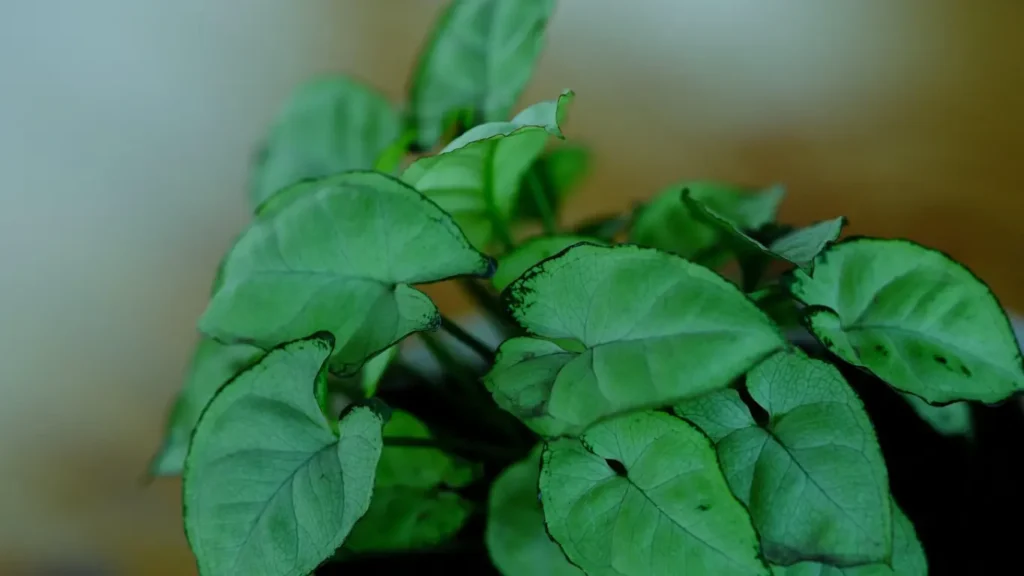
The Arrowhead Plant (Syngonium podophyllum), with its striking arrow-shaped leaves and adaptable nature, is a favorite among houseplant lovers. This definitive guide provides everything you need to know, from basic care to advanced tips, ensuring your Syngonium thrives indoors.
Table of Contents
Arrowhead Plant (Syngonium) Care at a Glance: Quick Guide
Essential Care Requirements:
• Light: Bright, indirect light (avoid direct sun). Tolerates lower light but may lose variegation/vibrancy • Watering: Water thoroughly when the top 1-2 inches of soil are dry. Avoid overwatering • Soil: Well-draining, peat-based potting mix • Humidity: Prefers moderate to high humidity (mist regularly, use a pebble tray, or humidifier) • Temperature: Average room temperatures (65-80°F / 18-27°C). Protect from drafts • Fertilizing: Feed monthly during spring/summer with a balanced liquid fertilizer • Toxicity: Mildly toxic to pets and humans if ingested due to calcium oxalate crystals
Meet the Arrowhead Plant: An Introduction to Syngonium podophyllum
Origins & Natural Habitat
The Arrowhead plant originates from the tropical rainforests of Central and South America, where it thrives in the warm, humid understory. Understanding its natural environment is crucial for successful arrowhead plant care, as it helps explain why these plants prefer consistent moisture, filtered light, and higher humidity levels than typical houseplants.
Distinctive Features: From Arrow Leaves to Climbing Vines
One of the most fascinating aspects of Syngonium podophyllum care is witnessing the plant’s remarkable transformation. Young Arrowhead plants display the characteristic arrow-shaped leaves that give them their common name. However, as they mature, these leaves evolve into deeply lobed, multi-fingered foliage.
In their natural habitat, Arrowhead plants are vigorous climbers, using aerial roots to ascend trees and other structures. This vining nature means your indoor plant will eventually need support or can be allowed to trail beautifully from a hanging basket.
Why is it Called Arrowhead Plant?
The distinctive arrow-shaped juvenile leaves are the source of this plant’s most popular common name. Other names include Nephthytis, Goosefoot plant, and American Evergreen, though these terms are sometimes used interchangeably with related species.
Perfecting Arrowhead Plant Care: The In-Depth Guide
Light Requirements: Finding the Sweet Spot for Your Syngonium
Understanding “Bright, Indirect Light”
When learning how to grow Arrowhead plant successfully, lighting is perhaps the most critical factor. Bright, indirect light means your plant should receive plenty of ambient light without direct sun rays hitting the leaves. Perfect locations include:
- Near an east-facing window (gentle morning sun)
- 3-4 feet away from south or west-facing windows
- Behind sheer curtains that filter harsh sunlight
Signs of Lighting Issues:
| Problem | Symptoms | Solution |
|---|---|---|
| Too Much Light | Scorched, brown patches on leaves | Move further from window or add sheer curtain |
| Too Little Light | Leggy growth, loss of variegation, pale leaves | Move closer to light source |
| Just Right | Compact growth, vibrant colors, new leaves regularly | Maintain current position |
Watering Wisdom: How (and How Often) to Water Your Arrowhead Plant
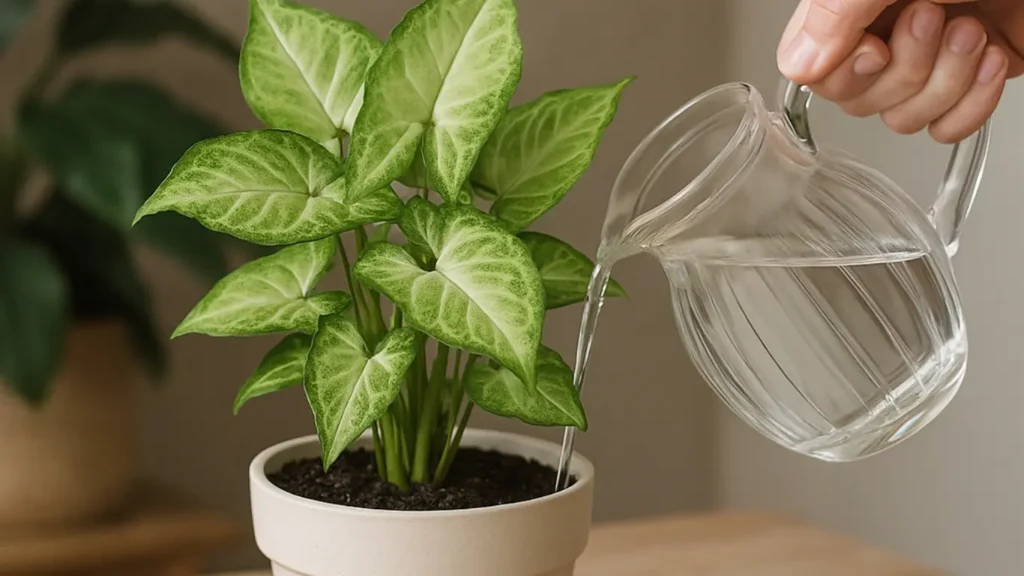
The “top inch dry” rule is your best friend for syngonium podophyllum care. Insert your finger about 1-2 inches into the soil – if it feels dry, it’s time to water.
Proper Watering Technique:
- Water thoroughly until excess drains from the bottom
- Empty the drainage tray after 30 minutes
- Never let the plant sit in standing water
Factors Affecting Watering Frequency:
- Light levels (brighter light = more frequent watering)
- Temperature (warmer = more frequent)
- Pot size (smaller pots dry out faster)
- Season (less frequent in winter)
Warning Signs:
- Overwatering: Yellow leaves starting from the bottom, musty soil smell, soft stems
- Underwatering: Wilting, crispy leaf edges, soil pulling away from pot sides
The Ideal Soil Mix for Happy Arrowhead Plant Roots
Proper drainage is absolutely essential for successful arrowhead plant care. Your Syngonium needs soil that retains some moisture while allowing excess water to escape quickly.
DIY Soil Mix Recipe:
- 40% peat moss or coco coir
- 30% regular potting soil
- 20% perlite or vermiculite
- 10% pine bark or orchid bark
Commercial Alternatives: High-quality houseplant potting mixes work well, particularly those designed for tropical plants or aroids.
Humidity Hacks: Creating a Tropical Oasis for Your Arrowhead
Arrowhead plants thrive in 40-60% humidity, which is higher than most homes naturally provide. Here are proven methods to boost humidity for optimal syngonium podophyllum care:
Most Effective Methods:
- Humidifier: Most consistent option for multiple plants
- Pebble Tray: Fill a tray with pebbles and water, place pot on top
- Plant Grouping: Cluster plants together to create a microclimate
- Bathroom Placement: Naturally higher humidity from showers
Misting Considerations: While misting can help, avoid overdoing it as constant moisture on leaves can promote fungal issues.
Temperature & Airflow: Keeping Your Syngonium Comfortable
Arrowhead plants prefer consistent temperatures between 65-80°F (18-27°C). They’re particularly sensitive to:
- Cold drafts from windows or air conditioning
- Heat from radiators or heating vents
- Sudden temperature fluctuations
Feeding Your Arrowhead: Fertilizer Facts & Schedules
Growing Season (Spring/Summer):
- Feed monthly with balanced liquid fertilizer (10-10-10 or 20-20-20)
- Dilute to half the recommended strength
Dormant Season (Fall/Winter):
- Reduce feeding to every 6-8 weeks or stop entirely
Signs of Over-fertilization:
- Brown leaf tips despite adequate humidity
- White salt buildup on soil surface
- Excessive, weak growth
Advanced Arrowhead Plant Management: Pruning, Repotting & Support
Pruning Your Arrowhead Plant: Encouraging Bushiness & Controlling Size
Regular pruning is key to maintaining an attractive, full Arrowhead plant. The best time to prune is during active growing seasons (spring and summer).
Pruning Benefits:
- Encourages bushier, fuller growth
- Controls size and shape
- Removes leggy or damaged growth
- Provides cuttings for propagation
How to Prune:
- Use clean, sharp scissors or pruning shears
- Cut just above a node (where leaves emerge)
- Remove up to 1/3 of the plant at once
- Save healthy cuttings for propagation
Repotting Your Syngonium: When and How to Give it More Space
Signs Your Plant Needs Repotting:
- Roots growing through drainage holes
- Water runs straight through without being absorbed
- Plant has been in the same pot for 2+ years
- Growth has significantly slowed
Repotting Steps:
- Choose a pot 1-2 inches larger in diameter
- Prepare fresh, well-draining potting mix
- Gently remove plant and inspect roots
- Trim any black, mushy roots
- Plant at the same depth as before
- Water thoroughly and place in bright, indirect light
Supporting Your Arrowhead: Embracing its Vining Nature
As your Arrowhead plant matures, you’ll notice its natural climbing tendency. Providing support not only accommodates this growth pattern but often results in larger, more mature-looking leaves.
Support Options:
- Moss Poles: Most popular choice, provides moisture and climbing surface
- Bamboo Stakes: Simple and affordable for smaller plants
- Trellises: Decorative option for trailing growth
- Hanging Baskets: Let it cascade naturally
Multiply Your Collection: Easy Arrowhead Plant Propagation
Propagating Arrowhead Plants from Stem Cuttings
Propagation is one of the most rewarding aspects of arrowhead plant care, and Syngoniums are among the easiest houseplants to propagate.
Water Propagation Method:
- Cut a 4-6 inch stem with at least 2-3 nodes
- Remove lower leaves that would sit in water
- Place cutting in clean water
- Change water every 3-4 days
- Roots develop in 1-2 weeks
- Transplant when roots are 1-2 inches long
Direct Soil Propagation:
- Follow steps 1-2 above
- Dip cutting in rooting hormone (optional)
- Plant in moist potting mix
- Keep soil consistently moist
- Place in bright, indirect light
- New growth indicates successful rooting
Air Layering Arrowhead Plants
For larger, more established plants, air layering can be used to propagate while the cutting remains attached to the parent plant. This method has higher success rates but is more complex and typically unnecessary for most home growers.
Exploring the Diversity: Popular Arrowhead Plant (Syngonium) Varieties
The world of Syngonium varieties offers exciting options for collectors and casual growers alike. Each variety has slightly different care requirements, but all follow the basic principles of arrowhead plant care.
Popular Varieties:
| Variety | Key Features | Special Care Notes |
|---|---|---|
| ‘White Butterfly’ | Classic white and green variegation | Most common and easiest to find |
| ‘Pink Allusion’ | Pink-tinged leaves with green edges | Needs brighter light to maintain pink coloring |
| ‘Neon Robusta’ | Bright lime-green foliage | Very vigorous grower |
| ‘Mini Pixie’ | Compact dwarf variety | Perfect for small spaces, slower growing |
| ‘Cream Allusion’ | Cream and green variegation | Similar care to ‘White Butterfly’ |
| ‘Painted Arrow’ | Multi-colored leaves with pink, white, and green | Requires higher humidity for best coloration |
Arrowhead Plant SOS: Identifying and Solving Common Issues
Even with excellent syngonium podophyllum care, problems can arise. Quick identification and treatment are key to maintaining plant health.
Common Problems and Solutions
| Problem | Likely Causes | Solutions |
|---|---|---|
| Yellowing Leaves | Overwatering, underwatering, natural aging, nutrient deficiency | Check soil moisture, adjust watering schedule, fertilize if needed |
| Brown Leaf Tips/Edges | Low humidity, inconsistent watering, fertilizer burn | Increase humidity, improve watering consistency, reduce fertilizer |
| Leggy Growth | Insufficient light, natural aging | Move to brighter location, prune for bushier growth |
| Drooping/Wilting | Underwatering, overwatering, temperature stress | Check soil and roots, adjust care routine |
| Loss of Variegation | Too little light, over-fertilization | Move to brighter indirect light, reduce fertilizer |
Pest Management
Common Pests:
- Spider Mites: Fine webbing, tiny moving specks
- Mealybugs: White, cottony clusters
- Aphids: Small, soft-bodied insects on new growth
Organic Treatment Options:
- Neem oil spray (weekly applications)
- Insecticidal soap solution
- Rubbing alcohol on cotton swabs for spot treatment
- Increase humidity (deters spider mites)
Important Safety Note: Arrowhead Plant Toxicity
Arrowhead plants contain calcium oxalate crystals, making them mildly toxic to both pets and humans if ingested. Understanding this aspect of syngonium podophyllum care is crucial for households with children or pets.
Symptoms if Ingested:
- Mouth and throat irritation
- Difficulty swallowing
- Excessive drooling (in pets)
- Vomiting (rare)
Safety Precautions:
- Keep plants out of reach of children and pets
- Wear gloves when handling or pruning
- Wash hands thoroughly after plant care
- Consider placement on high shelves or in rooms with restricted access
Your Arrowhead Plant Questions Answered (Expert FAQ)
How fast does an Arrowhead Plant grow?
Arrowhead plants are moderate to fast growers, typically producing 4-6 new leaves per month during the growing season. Growth rate depends on light, temperature, humidity, and overall care quality.
Can Arrowhead Plants live in water permanently?
While Arrowhead plants can survive in water for extended periods, they thrive better in soil. Water propagation is excellent for rooting cuttings, but permanent water culture may lead to weaker growth and increased susceptibility to root rot.
Why are my Arrowhead Plant leaves losing their variegation?
Loss of variegation typically indicates insufficient light. Variegated plants need brighter conditions to maintain their colorful patterns. Move your plant closer to a light source while avoiding direct sun.
Is the Arrowhead Plant good for air purification?
While Arrowhead plants do process air like all plants, they weren’t included in NASA’s famous air purification study. They provide some air-cleaning benefits but shouldn’t be relied upon as primary air purifiers.
How do I make my Arrowhead Plant bushier?
Regular pruning encourages bushier growth by stimulating new shoots from the base. Pinch or cut growing tips just above nodes, and ensure adequate light to prevent leggy growth.
What are the little bumps on my Arrowhead Plant stem?
These are aerial roots, completely normal for climbing plants like Syngoniums. They help the plant climb in nature and indicate healthy growth. You can trim them if desired or use them to attach the plant to a moss pole.
Your Journey to Arrowhead Plant Success
The Arrowhead plant’s adaptability and forgiving nature make it an excellent choice for both beginners and experienced plant parents. By understanding its natural habitat and providing consistent care based on its tropical origins, you’ll be rewarded with a stunning, ever-changing houseplant that brings natural beauty to your home.
Remember that successful arrowhead plant care comes down to finding the right balance of light, water, and humidity while allowing the plant to express its natural vining tendency. With the comprehensive knowledge you’ve gained from this guide, you’re well-equipped to grow healthy, vibrant Syngoniums that will thrive for years to come.
The key to mastering syngonium podophyllum care lies in observation and consistency. Pay attention to your plant’s signals, adjust care as needed, and don’t be afraid to experiment with different varieties to find your favorites.
What’s your favorite Arrowhead Plant variety, or what challenges have you faced? Share your experiences and questions in the comments below!
Author
George Wine is a seasoned gardening expert with over 20 years of experience in the field of horticulture. His passion for plants and nature has driven his career, where he has honed his skills in various aspects of gardening, from landscape design to plant care. George holds a Master of Science in Horticulture from the University of California, Davis (UC Davis), a prestigious institution known for its research and advancements in plant science.
Throughout his career, George has worked with a diverse range of clients, offering tailored solutions to enhance outdoor spaces and create thriving gardens. His knowledge and expertise allow him to provide invaluable advice, ensuring that both novice and experienced gardeners achieve their gardening goals. Whether you’re looking for tips on sustainable gardening practices, innovative design ideas, or advice on specific plant species, George is here to help you cultivate the garden of your dreams.

